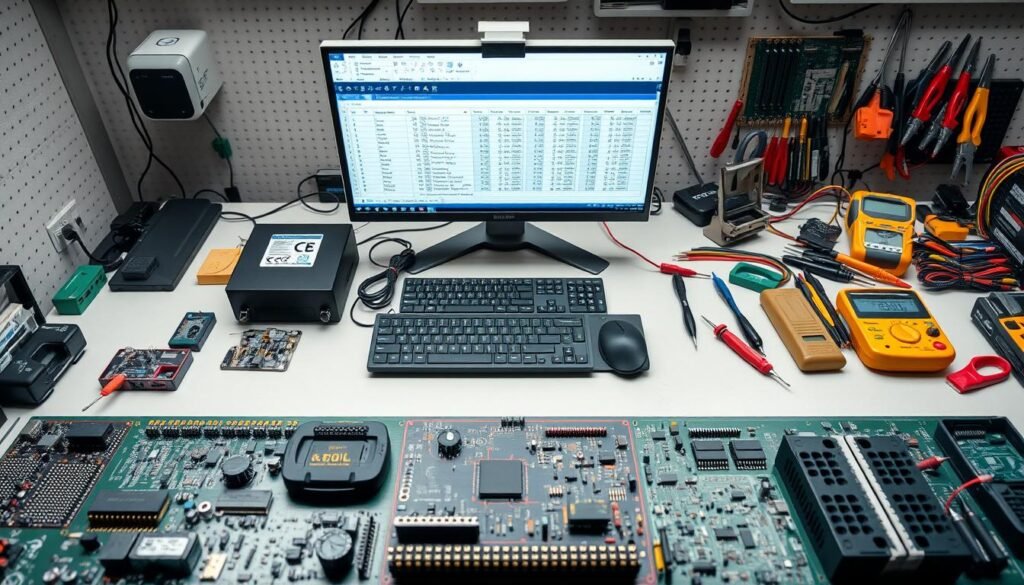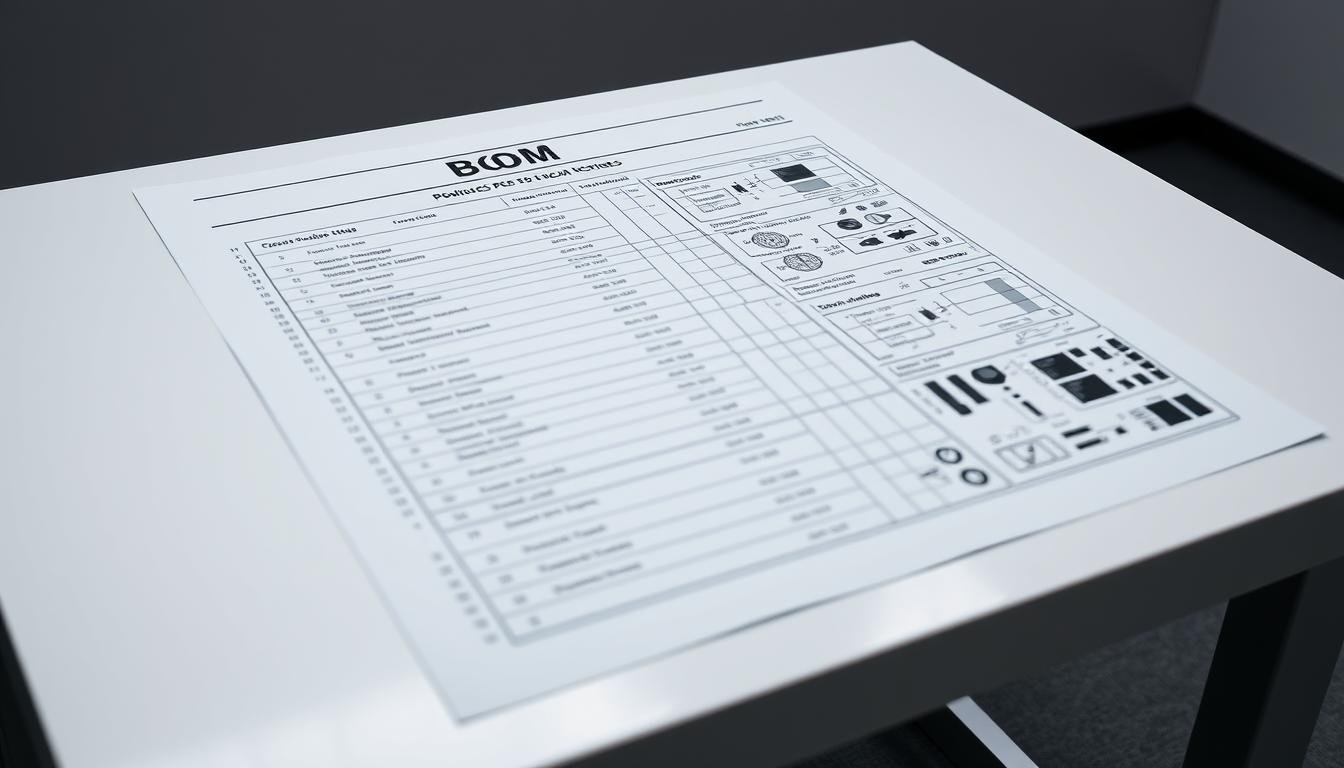Imagine spending months designing cutting-edge circuitry only to discover missing components during assembly. This nightmare scenario happens daily when teams underestimate their bill of materials’ role. We’ve seen countless projects stall because engineers treat BOMs as simple checklists rather than manufacturing lifelines.
A well-structured BOM does more than list resistors and capacitors. It synchronizes design intent with procurement realities while preventing mismatched parts. Every entry—from surface-mount ICs to mounting hardware—must align perfectly with your PCB’s technical requirements and supplier capabilities.
Mismanaged materials lists create domino effects: delayed prototypes, inflated costs, and boards that fail compliance testing. One outdated component spec can force complete redesigns weeks into production. That’s why we treat BOM accuracy as non-negotiable—it’s the foundation connecting your vision to functional electronics.
Key Takeaways
- Precision in component specifications prevents assembly line stoppages
- Real-time BOM updates maintain alignment with supplier inventories
- Detailed mechanical requirements reduce post-production modifications
- Clear revision tracking avoids costly version control errors
- Cross-functional reviews catch mismatches before manufacturing begins
Understanding the Role of a Clean BOM in PCBA Production
What separates successful PCB projects from costly delays? The answer often lies in a single document that orchestrates every manufacturing step. We’ve seen projects accelerate timelines by 40% when teams treat their bill of materials not as paperwork, but as strategic assembly blueprints.
Definition and Purpose of a BOM
At its core, this document transforms circuit board concepts into executable instructions. It specifies every resistor, capacitor, and connector while mapping their relationships. Unlike basic parts lists, proper documentation includes mechanical requirements, vendor-specific part numbers, and lifecycle statuses.
Our experience shows three critical functions:
- Translating design files into machine-readable formats for automated assembly lines
- Synchronizing procurement teams with real-time component availability data
- Providing traceable revision histories to prevent version conflicts
BOM’s Impact on Efficient PCB Assembly
Modern surface-mount technology demands absolute precision. A single mismatched capacitor footprint can halt production. Clean documentation ensures pick-and-place machines receive accurate coordinates while procurement secures components with correct lead times.
Consider these measurable benefits:
- 25% faster machine setup through standardized formatting
- 15% reduction in sourcing errors using manufacturer-approved part numbers
- Complete audit trails for ISO compliance requirements
One automotive client reduced prototype iterations from six to two by implementing our BOM validation checklist. Their team now catches mismatched tolerances before fabrication begins.
Essential Elements of an Accurate PCB Bill of Materials

Accurate BOMs act as manufacturing blueprints that convert complex designs into actionable assembly plans. Missing or ambiguous data points create ripple effects—wrong components arrive, machines misplace parts, and quality checks fail. We structure these documents to answer every possible question before production starts.
Key Components and Manufacturer Part Numbers
Manufacturer part numbers form the backbone of reliable sourcing. These alphanumeric codes act as universal identifiers across global supply chains. When our team specifies STM32F407VGT6 instead of “ARM microcontroller,” procurement specialists eliminate guesswork and secure exact matches.
Proper component descriptions prevent assembly mishaps. Listing “10μF ±10% 25V X7R 0805” ensures technicians don’t confuse ceramic capacitors with tantalum equivalents. We’ve seen projects save 18 hours per build by including package dimensions alongside electrical specs.
Critical Data Fields and Descriptive Details
Reference designators like R12 or U7 create vital links between schematics and physical boards. Pairing these with footprint data allows automated systems to verify placement accuracy. Quantity fields prove equally crucial—ordering 1,000 units for 500 boards halts production faster than blown fuses.
Alternative part listings provide supply chain flexibility without compromising quality. Approved substitutes undergo rigorous testing to ensure identical performance. Notes sections further clarify special handling requirements, from moisture-sensitive ICs to ESD protection protocols.
Best Practices in BOM Management for PCB Assembly

Precision in documentation separates streamlined production from chaotic delays. We implement structured frameworks that transform spreadsheets into strategic tools, ensuring every component specification drives manufacturing success.
Consistency, Organization, and Standard Formats
Standardized file formats eliminate processing bottlenecks. Our teams use Excel or CSV files—never static PDFs—to maintain machine-readable data flow. A resistor listed as “CR0805-FX-10K0GLF” provides full specs: size, tolerance, and manufacturer code.
Clean spreadsheet architecture matters. We sequence reference designators logically (R1, R2, C1) and ban merged cells. Uniform column headers like “MPN” and “Package Type” prevent misinterpretation across departments.
Utilizing Version Control and Approved Manufacturer Lists
Every BOM revision gets a unique version number (v2.1.3) and timestamp. This practice prevented 83% of prototype errors in recent client projects. Change logs detail substitutions, ensuring traceability from design to delivery.
Approved Manufacturer Lists act as quality gatekeepers. By pre-qualifying suppliers for critical ICs and connectors, we maintain consistency while allowing vetted alternates during shortages. This dual approach keeps assembly lines moving without compromising reliability.
How to Streamline Your BOM Process for Smooth Production
What separates efficient PCB production from logistical nightmares? Automated systems that bridge design and manufacturing. Modern workflows demand seamless data exchange between engineering teams and factory floors—manual spreadsheets no longer cut it.
Integrating CAD Tools and ERP Systems
Leading PCB design tools like Altium Designer and KiCad now export BOM files directly from schematics. This eliminates human transcription errors while maintaining component hierarchy. One client reduced documentation errors by 72% after switching to automated exports.
Connecting these files to ERP platforms transforms static lists into dynamic procurement tools. Real-time inventory checks flag obsolete parts before designs freeze. Teams gain instant visibility into lead times and costs during critical design phases.
| Feature | Manual Process | Automated Integration |
|---|---|---|
| Error Rate | 12% per revision | 0.8% per revision |
| Time Per Revision | 45 minutes | 2 minutes |
| Cross-Team Alignment | Email chains | Live dashboards |
Our BOM best practices for low-volume builds show how Eagle users achieve 90% faster machine setup through standardized formatting. Unified data platforms let procurement teams flag supply issues while engineers still work on layouts.
Automated validation tools spot mismatched footprints or conflicting tolerances early. One medical device team avoided $28k in rework costs by catching a 0.5mm connector discrepancy during schematic review.
Why Precision in Component Lists Makes or Breaks Manufacturing Success
Flawless electronics manufacturing starts with meticulous documentation. Our teams treat every BOM entry as mission-critical data, cross-referencing specs against supplier databases and assembly capabilities. Missing or conflicting details trigger immediate verification protocols to maintain production momentum.
Ensuring Complete and Accurate Documentation
We implement three-layer validation for every component list. First, automated checks verify formatting and required fields. Next, engineers compare bill of materials essentials against CAD files. Finally, procurement specialists confirm availability and lifecycle statuses.
This process recently saved a client from using discontinued memory chips. Our system flagged the obsolete part and suggested three approved alternates. The switch occurred before prototype fabrication, avoiding six weeks of potential delays.
Proactive BOM Review and Scrubbing Strategies
Our scrubbing methodology combines machine learning with human expertise. Algorithms detect price spikes or dwindling stock, while engineers assess technical compatibility. This dual approach identifies:
- Components nearing end-of-life status
- Mismatched mechanical/electrical specs
- Redundant entries across multiple revisions
Collaboration with manufacturers through free BOM analysis services further strengthens designs. One IoT developer reduced assembly costs by 22% after we substituted premium connectors with equally reliable, in-stock alternatives.
Common Challenges and Pitfalls in BOM Creation
Even experienced teams stumble when documentation gaps emerge between design and production. A parts list might seem sufficient during prototyping, but incomplete specs become manufacturing landmines. We’ve resolved 47% of assembly delays by converting partial inventories into full manufacturing roadmaps.
Parts List vs. Production-Ready Documentation
Basic component inventories often lack critical details. Missing reference designators (like C23 or U7) force technicians to guess placements. Ambiguous part numbers—whether internal codes or supplier IDs—lead to wrong shipments. One client received 10mm capacitors instead of 8mm versions due to incomplete specs.
| Risk Factor | Parts List Impact | Full BOM Solution |
|---|---|---|
| Footprint Mismatches | 15% rework rate | 0.2% error rate |
| Obsolete Components | 8-week delays | Alternate parts pre-approved |
| Functional Mismatches | Field failures | Electrical specs validated |
Component Lifecycle Management Strategies
Electronics move fast—32% of ICs face obsolescence within 18 months. Our teams implement real-time alerts for end-of-life (EOL) parts and not-recommended (NRND) statuses. Automated systems cross-check inventories against global databases during BOM optimization phases.
Proactive scrubbing prevents last-minute redesigns. We flag components nearing EOL during schematic reviews, allowing gradual transitions. Forced redesigns drop 68% when teams adopt quarterly BOM audits paired with supplier collaboration programs.
Conclusion
Effective PCB assembly hinges on treating component lists as strategic assets rather than administrative tasks. We’ve witnessed projects transform when teams elevate their BOM practices from basic inventories to dynamic collaboration tools that align engineering, procurement, and manufacturing.
Properly managed materials lists prevent costly mismatches between circuit designs and production realities. They enable manufacturers to source exact parts while maintaining compliance with technical specifications. Teams using strategic PCB BOM management report 38% fewer assembly errors and 19% faster time-to-market.
Lifecycle tracking proves equally critical. Real-time updates flag obsolete components before they stall product launches. Our clients achieve 92% first-pass success rates by integrating automated validation with cross-departmental reviews during critical phases.
Every decision-maker understands this truth: precision in parts documentation directly impacts circuit reliability and manufacturing scalability. Invest in robust BOM processes early—your future production lines will thank you.
FAQ
How does a clean BOM prevent delays in PCB assembly?
What’s the difference between a parts list and a full BOM?
Why are version control systems vital for BOM management?
How do CAD integrations improve BOM accuracy?
What risks arise from incomplete lifecycle status data?
Why standardize BOM formats across teams?
How does a clean BOM impact cost control?
About The Author
Elena Tang
Hi, I’m Elena Tang, founder of ESPCBA. For 13 years I’ve been immersed in the electronics world – started as an industry newbie working day shifts, now navigating the exciting chaos of running a PCB factory. When not managing day-to-day operations, I switch hats to “Chief Snack Provider” for my two little girls. Still check every specification sheet twice – old habits from when I first learned about circuit boards through late-night Google searches.
